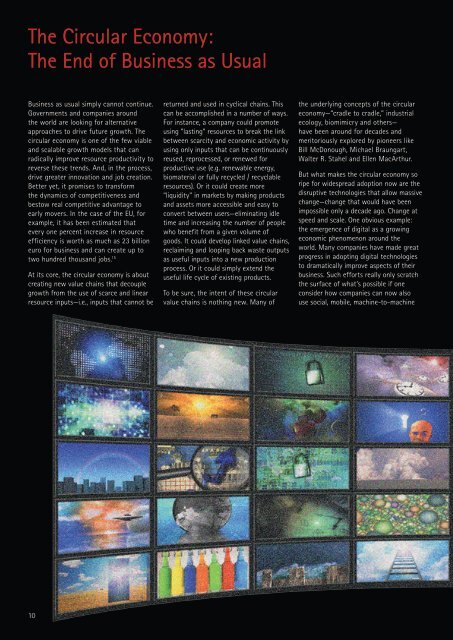Accenture-Circular-Advantage-Innovative-Business-Models-Technologies-Value-Growth
Accenture-Circular-Advantage-Innovative-Business-Models-Technologies-Value-Growth
Accenture-Circular-Advantage-Innovative-Business-Models-Technologies-Value-Growth
Create successful ePaper yourself
Turn your PDF publications into a flip-book with our unique Google optimized e-Paper software.
The <strong>Circular</strong> Economy:<br />
The End of <strong>Business</strong> as Usual<br />
<strong>Business</strong> as usual simply cannot continue.<br />
Governments and companies around<br />
the world are looking for alternative<br />
approaches to drive future growth. The<br />
circular economy is one of the few viable<br />
and scalable growth models that can<br />
radically improve resource productivity to<br />
reverse these trends. And, in the process,<br />
drive greater innovation and job creation.<br />
Better yet, it promises to transform<br />
the dynamics of competitiveness and<br />
bestow real competitive advantage to<br />
early movers. In the case of the EU, for<br />
example, it has been estimated that<br />
every one percent increase in resource<br />
efficiency is worth as much as 23 billion<br />
euro for business and can create up to<br />
two hundred thousand jobs. 15<br />
At its core, the circular economy is about<br />
creating new value chains that decouple<br />
growth from the use of scarce and linear<br />
resource inputs—i.e., inputs that cannot be<br />
returned and used in cyclical chains. This<br />
can be accomplished in a number of ways.<br />
For instance, a company could promote<br />
using ”lasting” resources to break the link<br />
between scarcity and economic activity by<br />
using only inputs that can be continuously<br />
reused, reprocessed, or renewed for<br />
productive use (e.g. renewable energy,<br />
biomaterial or fully recycled / recyclable<br />
resources). Or it could create more<br />
“liquidity” in markets by making products<br />
and assets more accessible and easy to<br />
convert between users—eliminating idle<br />
time and increasing the number of people<br />
who benefit from a given volume of<br />
goods. It could develop linked value chains,<br />
reclaiming and looping back waste outputs<br />
as useful inputs into a new production<br />
process. Or it could simply extend the<br />
useful life cycle of existing products.<br />
To be sure, the intent of these circular<br />
value chains is nothing new. Many of<br />
the underlying concepts of the circular<br />
economy—“cradle to cradle,” industrial<br />
ecology, biomimicry and others—<br />
have been around for decades and<br />
meritoriously explored by pioneers like<br />
Bill McDonough, Michael Braungart,<br />
Walter R. Stahel and Ellen MacArthur.<br />
But what makes the circular economy so<br />
ripe for widespread adoption now are the<br />
disruptive technologies that allow massive<br />
change—change that would have been<br />
impossible only a decade ago. Change at<br />
speed and scale. One obvious example:<br />
the emergence of digital as a growing<br />
economic phenomenon around the<br />
world. Many companies have made great<br />
progress in adopting digital technologies<br />
to dramatically improve aspects of their<br />
business. Such efforts really only scratch<br />
the surface of what’s possible if one<br />
consider how companies can now also<br />
use social, mobile, machine-to-machine<br />
10


